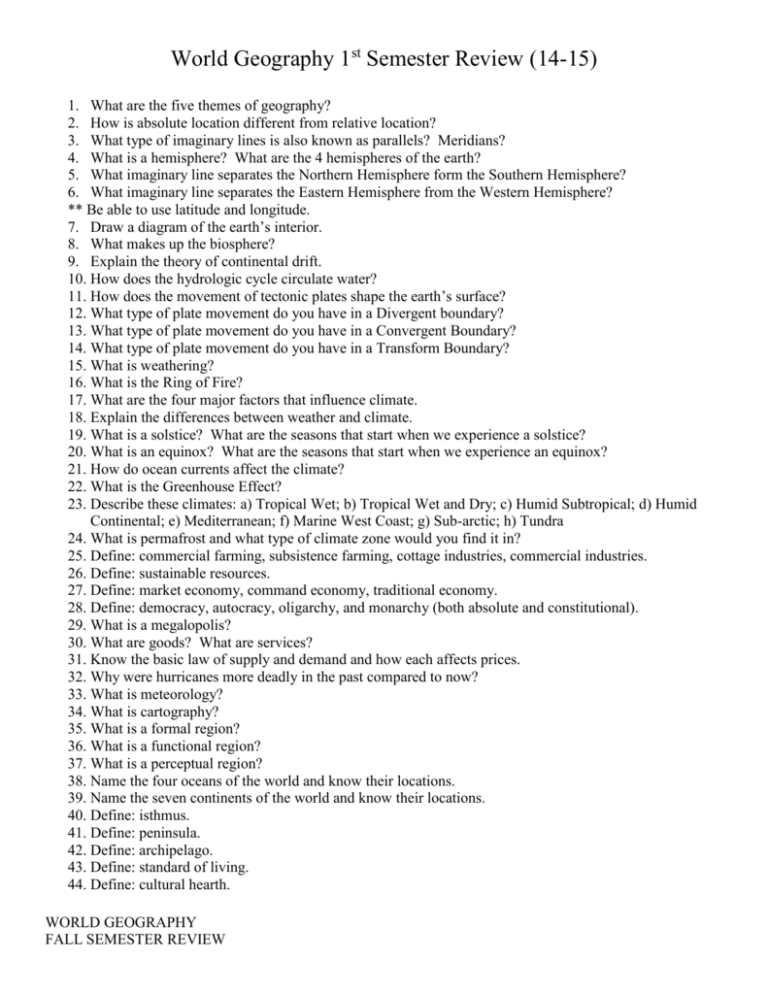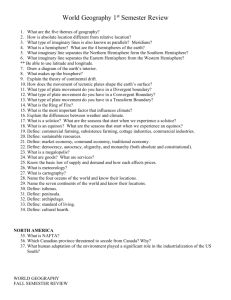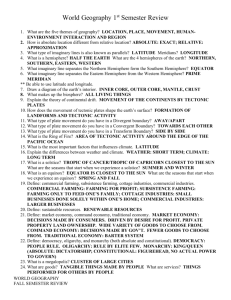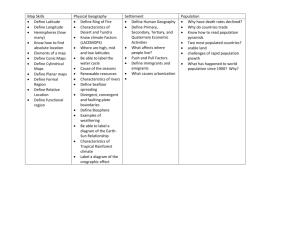World Geography 1st Semester Review (High School)
advertisement

World Geography 1st Semester Review (14-15) 1. What are the five themes of geography? 2. How is absolute location different from relative location? 3. What type of imaginary lines is also known as parallels? Meridians? 4. What is a hemisphere? What are the 4 hemispheres of the earth? 5. What imaginary line separates the Northern Hemisphere form the Southern Hemisphere? 6. What imaginary line separates the Eastern Hemisphere from the Western Hemisphere? ** Be able to use latitude and longitude. 7. Draw a diagram of the earth’s interior. 8. What makes up the biosphere? 9. Explain the theory of continental drift. 10. How does the hydrologic cycle circulate water? 11. How does the movement of tectonic plates shape the earth’s surface? 12. What type of plate movement do you have in a Divergent boundary? 13. What type of plate movement do you have in a Convergent Boundary? 14. What type of plate movement do you have in a Transform Boundary? 15. What is weathering? 16. What is the Ring of Fire? 17. What are the four major factors that influence climate. 18. Explain the differences between weather and climate. 19. What is a solstice? What are the seasons that start when we experience a solstice? 20. What is an equinox? What are the seasons that start when we experience an equinox? 21. How do ocean currents affect the climate? 22. What is the Greenhouse Effect? 23. Describe these climates: a) Tropical Wet; b) Tropical Wet and Dry; c) Humid Subtropical; d) Humid Continental; e) Mediterranean; f) Marine West Coast; g) Sub-arctic; h) Tundra 24. What is permafrost and what type of climate zone would you find it in? 25. Define: commercial farming, subsistence farming, cottage industries, commercial industries. 26. Define: sustainable resources. 27. Define: market economy, command economy, traditional economy. 28. Define: democracy, autocracy, oligarchy, and monarchy (both absolute and constitutional). 29. What is a megalopolis? 30. What are goods? What are services? 31. Know the basic law of supply and demand and how each affects prices. 32. Why were hurricanes more deadly in the past compared to now? 33. What is meteorology? 34. What is cartography? 35. What is a formal region? 36. What is a functional region? 37. What is a perceptual region? 38. Name the four oceans of the world and know their locations. 39. Name the seven continents of the world and know their locations. 40. Define: isthmus. 41. Define: peninsula. 42. Define: archipelago. 43. Define: standard of living. 44. Define: cultural hearth. WORLD GEOGRAPHY FALL SEMESTER REVIEW NORTH AMERICA 45. What is NAFTA? 46. Which Canadian province threatened to secede from Canada? Why? 47. What human adaptation of the environment played a significant role in the industrialization of the US South? 48. Where is Tornado Alley in the US? 49. Define: Co Divide, 50. What climate regions do the US & Canada share? Humid Continental, Semiarid, Marine West Coast, Desert 51. What is Beringia? It was a land bridge that once connected Asia to North America that early settlers may have used. 52. Explain the importance of the St. Lawrence Seaway & how it works. The seaway connects the Great Lakes to the Atlantic Ocean using a system of locks. 53. Why are the Great Lakes so important to North America? They provide an excellent means of transportation, fresh water, and wildlife habitat. 54. Draw a picture of the Columbian Exchange & explain its importance. North America Corn, turkey, potatoes, cacao, tobacco Europe Livestock, disease, sugar, grains, fruits, slaves The exchange shows how goods, ideas, and epidemics moved from continent to continent through trade. 55. What are the three branches of the US government and what does each do? Executive- carries out laws Legislative- enacts laws Judicial- interprets laws 56. What type of economy does the US use? Explain. The US is a free enterprise economy. Private individuals own most of the resources and forms of production. There is little interference by the government. 57. What makes the US such a culturally diverse country? The US was founded as a country of immigrants & has allowed immigrants throughout its history. With these new peoples come different cultures & ideas. Latin America 58. Why is Spanish the native language in so many Latin American countries? 59. Why is the Amazon Basin of importance to the world? How is it changing? The Amazon River flows more water than any other river in the world. The habitat around it is vast and diverse. It is ecologically important to the entire world. It provides the basis for medicines, habitat for countless species of animals, and helps to control global climate. Deforestation is robbing the area of its valuable resources. WORLD GEOGRAPHY FALL SEMESTER REVIEW 60. How do the following things affect the environment: slash & burn farming, terraced farming? Slash & burn- simple farming method that destroys rain forests and depletes the soil. Terraced farming- step like cuts made into the sides of mountains to allow for farmland. Can lead to erosion. 61. What is the difference between push & pull factors in migration? Push- something draws individuals to an area (jobs, climate, etc…) Pull- something forces individuals from and area (war, famine, pollution, etc…) 62. Why is the Panama Canal so important to world trade? The canal links the Atlantic & Pacific Oceans, therefore it links the economies of the world. 63. What are biodiversity, deforestation and global warming? Biodiversity- area with a wide range of plant and animal species. Deforestation- cutting & clearing of trees in the rain forests. May lead to global warming. Global warming- increase in global temperatures that effects global weather patterns. Latin America Map Mexico, Cuba, Panama, Colombia, Chile, Argentina, Brazil, Venezuela, Gulf of Mexico, Caribbean Sea, Atlantic Ocean, Pacific Ocean, Strait of Magellan, Cape Horn, Tierra del Fuego, Lake Maracaibo, Lake Nicaragua, Lake Titicaca, Bolivia, Paraguay, Honduras, Guatemala, Panama Canal, Andes Mountains, Sierra Madre Occidental, Sierra Madre Oriental, Sierra Madre del Sur, Yucatan Peninsula, Baja California, U.S., Amazon River, Angel Falls, Puerto Rico, Bahamas, Jamaica EUROPE 64. List 5 peninsulas of Europe and tell which countries they contain. 65. Explain how the Gulf Stream affects the climate of Europe. What part of the continent is effected? 66. What four areas make up the United Kingdom? 67. What does the saying “The sun never sets on the British Empire” refer to? 68. What is the European Union? The Euro? 69. What was the original purpose of the EU? 70. Define supranational. 71. Define sovereignty. 72. Define: strategic waterway. 73. What is chernozem? Where is it found in Europe? 74. What is a fjord? Where are they found in Europe? World Map Africa, Asia, Australia, Europe, North America, South America, Antarctica, Arctic Ocean, Atlantic Ocean, Pacific Ocean, Indian Ocean, Tropic of Cancer, Tropic of Capricorn, equator, Prime Meridian, Arctic Circle, Antarctic Circle Europe Map United Kingdom (Wales, Northern Ireland, Scotland, England), Greece, Spain, France, Sweden, Belgium, Norway, Italy, Denmark, Ireland, Switzerland, Germany, Poland, Romania, Hungary, Yugoslavia, Bosnia & Herzegovina, London, Rome, Paris, Prague, Berlin, Black Sea, Thames River, Danube River, North Sea, Mediterranean Sea, Adriatic Sea, Aegean Sea, Strait of Gibraltar, Alps, Apennine Mts., Pyrenees, Rhine River, Ireland, the Netherlands, Atlantic Ocean, Arctic Ocean, Portugal WORLD GEOGRAPHY FALL SEMESTER REVIEW





